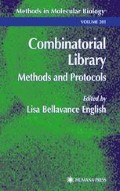Abstract
Rapid lead discovery in the drug development process relies on highthroughput screening of diverse compounds against protein targets. These compounds come from traditional organic synthesis, natural products isolation, and combinatorial synthesis (1). For compounds from combinatorial synthesis, the hit rate highly depends on the quality of the compounds. We employ parallel solid-phase (2) and solution-phase (3) synthesis methods to make lead discovery libraries containing approx 6000 compounds in each library.
Access this chapter
Tax calculation will be finalised at checkout
Purchases are for personal use only
References
Fenniri H. (2000) Combinatorial chemistry. A Practical Approach. Oxford University Press New York.
Seneci P. (2000) Solid-Phase Synthesis and Combinatorial Technologies. John Wiley & Sons New York.
Baldino C. M. (2000) Perspective articles on the utility and application of solution-phase combinatorial chemistry. J. Comb. Chem. 2, 89–103.
Maniara G., Rajamoorthi K., Rajan S., and Stockton G. W. (1998) Method performance and validation for quantitative analysis by 1H and 31P NMR spectroscopy. Applications to analytical standards and agricultural chemicals. Analyt. Chem. 70, 4921–4928.
Ellis D. A., Martin J. W., Muir D. C. G., and Mabury S. A. (2000) Development of an 19F NMR method for the analysis of fluorinated acids in environmental water samples. Analyt. Chem. 72, 726–731.
Fang L., Wan M., Pennacchio M., and Pan J. (2000) Evaluation of evaporative light-scattering detector for combinatorial library quantitation by reversed phase HPLC. J. Comb. Chem. 2, 254–257.
Fang L., Pan J., and Yan B. (2001) High-throughput determination of identity, purity and quantity of combinatorial library members using LC/MS/UV/ELSD. Bioeng. Biotech Comb. Chem. 71, 162.
Author information
Authors and Affiliations
Editor information
Editors and Affiliations
Rights and permissions
Copyright information
© 2002 Humana Press Inc.
About this protocol
Cite this protocol
Yan, B. et al. (2002). Analytical Methods for Optimization and Quality Control of Combinatorial Synthesis. In: English, L.B. (eds) Combinatorial Library. Methods in Molecular Biology™, vol 201. Springer, Totowa, NJ. https://doi.org/10.1385/1-59259-285-6:189
Download citation
DOI: https://doi.org/10.1385/1-59259-285-6:189
Publisher Name: Springer, Totowa, NJ
Print ISBN: 978-0-89603-980-3
Online ISBN: 978-1-59259-285-2
eBook Packages: Springer Protocols

